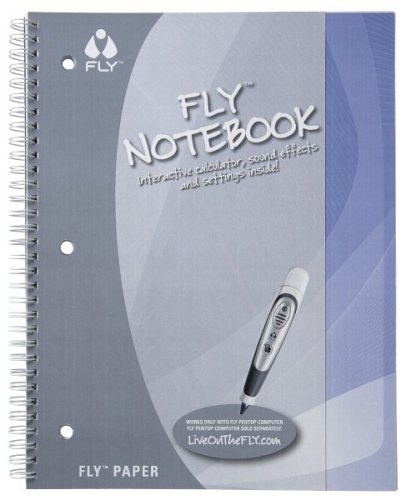
Picture taken from the actual commercial Channel One aired in classrooms. Looks like regular paper.
From Jim Metrock:
Channel One News is now advertising the FLY Pentop Computer by LeapFrog. The ads are aimed at the very youngest in C1N’s captive audience (5th through 8th grade students).
LeapFrog has struggled over the last few years. Their stock took a major dive, They needed a new product that would boost revenue. The FLY, they believe, is that product. A lot is resting on its success. LeapFrog sees in Channel One a way to not only advertise their expensive product ($100) to a captive audience of impressionable preteens, but also a way to get taxpayers to subsidize their ad campaign. Taxpayers pay for the building the audience sits in, the air conditioning and heat that makes it a comfortable setting to watch commercials and they enforce truancy laws that make viewing the advertisers “motivational films” basically mandatory.
The FLY is a small computer shaped like an over-sized pen. The ad that children saw was a “teaser” ad. This type of commercial should not be on Channel One since the young audience needs more information and less “come on.” The goal of the commercial is to get kids to nag their parents to buy this product.
I was intrigued by the ad as I am sure many preteens were. With this FLY pen you can draw a calculator and then touch the numbers you just drew, for example: 2+2=, and the pen will tell you (it has a speaker) that the answer is “four.” Whoa. You can also write a word in English and it will speak the word in Spanish. It will even spell the word in Spanish. .
I was amazed. How can you write out “hello” and the pen says “hola” and then spells it out “h-o-l-a”?
There has got to be a catch.
There is.
And Channel One doesn’t tell the young preteen audience about it, hoping they will buy the product and find out for themselves.
The commercial that ran on Channel One directed children to the flypentop.com web site. This site is very engaging. I was compelled to view much of the site because of the rather extraordinary interactive pages.
Even after touring the product site I still was surprised by what they didn’t tell me and what the ad on Channel One certainly didn’t tell me. The secret to the FLY pen is the paper. Preteens viewing the in-classroom commercial would, like me, think you could write on regular paper. That is the impression the ad gave. That was a deceptive impression. You need special paper, which is not cheap, that is, of course, not reusable. LeapFrog is the only source for the paper – surprise.
They call it FLY Paper. Clever. Calling it “Fly Paper” is appropriate. Once this deceptive ad lures a child to nag their parents to purchase the pen computer, LeapFrog has got the child trapped into buying more and more paper or the pen computer is useable.
The classroom ad does show a graph paper which is what the “flypaper” looks like, but at other times the paper looks ordinary. The voice-over never says you need special paper. Maybe the extremely fine print tells the truth to students.
Schoolchildren also see a “FLY Journal” on the ad and the perception is if you buy the FLY pen you can keep a journal. Well, you can do that but it is a separate add-on product that costs about $30. The voice-over quickly mentions some things cost extra, but why prominently display something that is an additional cost (one third the price of the pen itself). This is just one of the many violations of CARU advertising guidelines. (Children Advertising Review Unit is an ad industry group that tries to self-police advertisers. A Channel One advertiser has gotten in trouble with CARU before.
Obligation filed a compliant about Channel One’s advertising of Zapzyt, an acne medicine. CARU had secured an agreement with Waltman Pharmaceuticals, maker of Zapzyt, to discontinue airing commercials during children’s programming (12 and under). The product was considered a medication and therefore inappropriate to advertise during programming aimed at preteens. The product contained 10% Benzoyl Peroxide – more than a normal over-the-counter acne medicine. Months later, AFTER the agreement, Channel One agreed to run the Zapzyt ads in middle schools. Obligation protested and CARU contacted Waltman and the ads stopped. Channel One knew what they were doing. The CARU agreement was public knowledge. Channel One executives were just lazy or indifferent to the health of their preteen audience.
When we hear back from CARU, we will post their reply.
From one online reviewer:
“We’ve got a sneaking suspicion that LeapFrog (which makes gadgets for kids like the Leapster) is in for one helluva time marketing their new FLY pentop computer. The FLY, for lack of a better description, is essentially a pen-based computer for kids that lets you write stuff down on paper and then interact with your drawings. It uses the same Anoto digital pen technology that’s used by Sony Ericsson, Nokia, KDDI, and others in their Bluetooth pens; basically you have to write everything on special paper that comes with tons of little microdots printed on it, and the dots are read by a special tiny optical sensor on the pen. The pen comes with several onboard applications, like games, an alarm clock, and a note pad—there are also plans to sell a bunch of different products that take advantage of the technology, like math and spelling workbooks that can offer real-time feedback when you (or hopefully, your kid) make a mistake. As long as you remember to use that special paper, you can do stuff like make a calculator (touch your pen to the handwritten digits to make calculations, and the pen will actually use its speech synthesizer to read out the answer); a piano keyboard (it plays by tapping the pen on different “keys”), or write out a word in English and have it translated into Spanish. Won’t be out until the fall, but should cost around $99 when it gets here.”
|
Channel One should never have run this ad. Multiple CARU guidelines were violated. The fine print is unreadable. It was meant to be unreadable. |
Uh oh, the ad on Channel One didn’t say the FLY only works with special paper. Guess what company is the only source for the expensive paper? |
Channel One’s executives may say this ad was not aimed at preteens, but the manufacturers own site says, “The FLY Pentop Computer offers solutions for students in grades 3–8.” One look at this gadget and you know that no high school student would ever be caught with it in their backpack. This is geared towards “tweens.”
|
Pertinent sections of CARU guidelines.
|
|
1. Advertisers should always take into account the level of knowledge, sophistication and maturity of the audience to which their message is primarily directed. Younger children have a limited capacity for evaluating the credibility of information they receive. They also may lack the ability to understand the nature of the personal information they disclose on the Internet. Advertisers, therefore, have a special responsibility to protect children from their own susceptibilities. 2. Realizing that children are imaginative and that make-believe play constitutes an important part of the growing up process, advertisers should exercise care not to exploit unfairly the imaginative quality of children. Unreasonable expectations of product quality or performance should not be stimulated either directly or indirectly by advertising. 4. Recognizing that advertising may play an important part in educating the child, advertisers should communicate information in a truthful and accurate manner and in language understandable to young children with full recognition that the child may learn practices from advertising which can affect his or her health and well-being. Product Presentations and Claims Children look at, listen to and remember many different elements in advertising. Therefore, advertisers need to examine the total advertising message to be certain that the net communication will not mislead or misinform children. 1. Copy, sound and visual presentations should not mislead children about product or performance characteristics. Such characteristics may include, but are not limited to, size, speed, method of operation, color, sound, durability and nutritional benefits. 2. The advertising presentation should not mislead children about benefits from use of the product. Such benefits may include, but are not limited to, the acquisition of strength, status, popularity, growth, proficiency and intelligence. 3. Care should be taken not to exploit a child’s imagination. Fantasy, including animation, is appropriate for younger as well as older children. However, it should not create unattainable performance expectations nor exploit the younger child’s difficulty in distinguishing between the real and the fanciful. 4. The performance and use of a product should be demonstrated in a way that can be duplicated by the child for whom the product is intended. 6. What is included and excluded in the initial purchase should be clearly established. 1. All disclosures and disclaimers that are material to a child should be in language understandable by the child audience, legible and prominent. When technology permits, both audio and video disclosures are encouraged, as is the use of demonstrative disclosures. 3. If any item essential to use of the product, such as batteries, is not included, this fact should be disclosed clearly. 4. Information about products purchased separately, such as accessories or individual items in a collection, should be disclosed clearly. |
We will have video of this ad soon. You can see it on the video
replay of March 22, 2006 at Channelonenetwork.com.



